All About Alistar - A Guide With Aphromoo
A guide on everything you need to know to pick up and start your climb with League of Legends’ oldest tank, Alistar!
A guide on everything you need to know to pick up and start your climb with League of Legends’ oldest tank, Alistar!
If you’re on the hunt for your next Tank Support to adopt in the bot lane, boy have I got the cow for you! Alistar is one of League’s classic Champions, having been in the game since its inception, and even running a kit as old as mud itself hasn’t slowed this bad-bull down. Well, to be fair, he has had a few changes to keep his identity sleek and modern over the course of League’s progression… but, his core has always been tried and true.
So, today we’re going to talk about the Minotaur himself and walk through everything you need to know about Alistar! And we can’t get moo-tivated without the wise words of DIG’s very own Aphromoo watching over our shoulders. So, this guide is going to come equipped with plenty of tips that the Amoozing Aphro used to carry his record to 8-2 on Alistar over the 2021 Spring LCS Split!
Here’s what Aphro has to say about Alistar within the confines of Solo-Queue:
He brings sustain, has good engage, is super tanky, and can be played into almost every matchup. And pairs well with every Marksman. Can’t go wrong picking him up if you’re a new or old player.
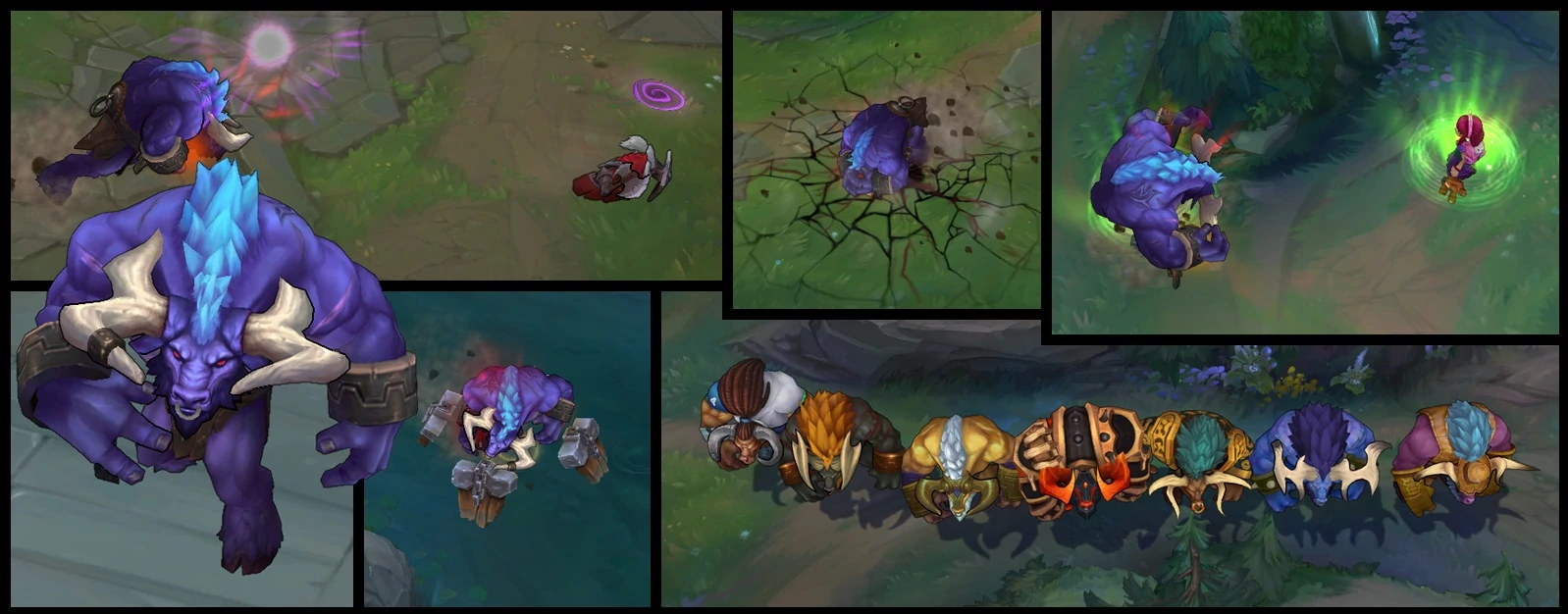
Passive - Triumphant Roar
Alistar gains a stack of Triumph every time he displaces or stuns a Champion with his Q, W, or E and whenever an enemy minion or non-epic monster dies nearby. Whenever Alistar reaches 7 stacks of Triumph, he roars, healing himself for 25-161 health (based on level) and his allies for double that amount.
Alistar roars instantly if an epic monster or enemy Champion dies near him, but upon consumption of his stacks he cannot roar again for a short duration, but he can still gain stacks.
Q - Pulverize
Alistar slams the ground dealing magic damage to all nearby enemies, stunning them, and knocking them up for 1 second.
W - Headbutt
Alistar dashes to the target enemies’ location. If the target is within 400 units upon arrival he deals magic damage to them, knocks them back, and stuns them for 1 second.
E - Trample
Alistar becomes ghosted and tramples the ground around him every 0.5 seconds for 5 seconds dealing magic damage to all nearby enemies and gaining a stack of Trample each time he damages at least one enemy Champion. At 5 stacks, Alistar’s next basic attack within 6 seconds deals magic damage and stuns the struck enemy for 1 second.
R - Unbreakable Will
Alistar cleanses himself of all crowd-control and for the next 7 seconds takes reduced damage from all sources.
So, the quick TL;DR here is that he’s got three forms of CC. Two-quick hard CC options with Q and W, and one follow up in the form of E’s stun that takes a little bit to get going. On top of that, he has extra survivability in the form of his ultimate cleansing him and reducing the damage he takes upon activation.
As a melee and engage-focused Champion, Alistar excels in situations where he’s allowed to sit and time his moments without interruption. Great Alistars look for windows around big ability whiffs like missed CC, down flashes and dashes, or mistimed defensive abilities like shields to make his primary engagements.
Alistar also excels when it comes to counter engage setups. His Headbutt into Pulverize is quite effective at locking down a primary carry to allow for his own to kite back. Headbutt alone can easily take any CC-vulnerable attacker out of range too, while he utilizes his Q to lock down a forward engaging opponent. It’s all about reading what situation you’re in and how to best dictate the fight with patient ability usage
So, Alistar naturally shines in matchups against other Tanks who are looking for the same setups, and against Hook-Champions who often ‘fish’ for their ways in. These matchups afford the time and safety that Alistar enjoys to look for his own opportunities, and if he can’t find it himself, their engagements become his own.
However, against Mages and Enchanters and other poke oriented style Supports that can keep his health down, which dissuades him from going in, or worse, can disrupt his combo entirely he suffers. So, matchups like Janna, Lulu, Sona, and Bard are examples of his worst situations since these Champions provide poke and CC do just what we previously mentioned to his interruptible setup.
Aphro has a couple of picks to avoid as well:
Alistar can be played into most everything with good timing. But the ones that are the hardest are Morgana and Tahm Kench. You can still play into those, but you won’t have a ton of priority in the matchup.
Makes sense. Alistar’s bread and butter combo Headbutt//Pulverize, is a magic damage-crowd control combo that gets negated easily by Morgana’s E, Black Shield, which defends against magic damage and prevents crowd control from sticking. Morgana is essentially the dictator of the pace here and has to whiff her Black Shield target for Ali to be able to come out on top.
Tahm Kench’s Devour can eat the primary target out of Alistar’s combo, putting the focus on himself, which isn’t the greatest thanks to his grey health shield that he can use to remain the target for even longer. Afterwards he’ll be spitting out his devoured target and allowing them to mess Alistar up in return and likely return the lane state in his favor.
And these aren’t even considering the Ultimate usages that these Champions have around Alistars which provide positional utility in terms of TK, and zone pressure with Morgana.
The only two Keystones are Phase Rush and Aftershock. Any other sets after that are just awful. There’s not a lot of selection there. But, the masteries (lesser runes in the Keystone tree) offer a wider selection. Would like it if there were more, but.. But yeah, stick to the two: Phase Rush and Aftershock. For the secondary tree, you’re almost always going Inspiration and looking to take Hexflash. The other one can be whatever you’d like it to be. Future’s Market, Biscuits, Cosmic Insight, whatever. But again, Hexflash is a must.
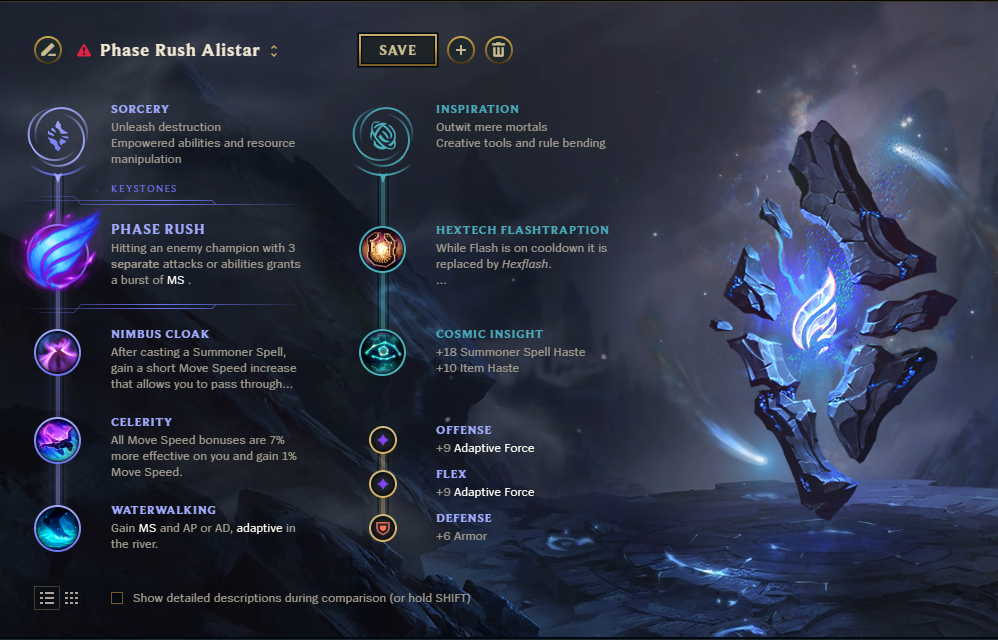
Here’s a typical example of the Phase Rush Alistar set. Phase Rush’s speed boost allows Alistar to stay in range on top of his target for his E stun, while also giving him the ability to quickly reposition for effective use of his CC should he weave an auto into the mix of his engagements.
This set is typically lighter in terms of tankier attributes and focuses a ton around Alistar’s early and mid game relying on his okay base damage values and his high impact roaming. This can be seen through the selections of Nimbus Cloak, Celerity, and Waterwalking which increases his speed out of lane to gank Mid or support the Jungle. In the minor rune department, we elect for double adaptive over armor or magic resistance. We also opt for Cosmic Insight as our secondary rune alongside Hexflash to have our engages be available on a lower timer thus increasing our usage of Phase Rush’s effects and increasing our pressure.
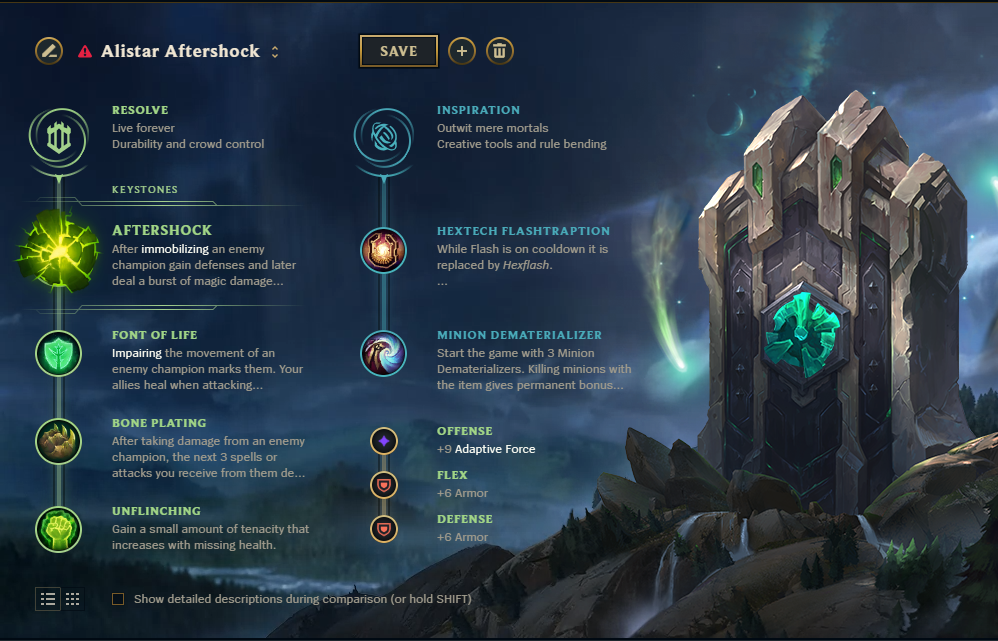
For the Aftershock set, you’re almost always going Font of Life. In the next tree you can opt for Bone Plating or Second Wind depending on your matchup. And again between Unflinching and Overgrowth.
Aftershock naturally synergizes with Alistar getting him tankier as he makes his all-in since his primary engage is an immobilizing effect. Same can be said for Font of Life which rides off the same effect. Bone Plating can be opted for in Tank vs Tank matchups and synergizes well with Aftershock should Alistar be caught as the focus of engage. Second Wind should be opted against Enchanters and Mages that like to poke Alistar down to help him maintain his presence in lane. Unflinching increases Alistar’s slipperiness, preventing him from being perma-cc’d so he can make his plays without interruption and should be taken into comps that have easy to drop CC. Overgrowth can be taken alongside comps or lanes that are looking to scale, and this rune naturally promotes Alistar’s most desired stat, health.
In terms of minor runes you can be flexible. You can run any combination depending on your enemy team comp. Double armor is the example here, and you can never go wrong with it since the primary damage in Bot lane is typically AD, but flexing to MR or health against AP Junglers or roaming Mids is never a bad decision.
Remember, first you gotta blow your Flash, and then you can use Hexflash. After that, Hexflash can be used to pressure the enemy team since you have farther engage ranges than normal. It can be used to get over walls, if the opponent is just standing in a brush, or if they’re approaching your way to get a combo off. Learning to play with this rune gives a lot of variability with your approach since you’re not just stuck on your Champion after you blow Flash, and teams can’t just space around you if you’ve got Hexflash up. But the key is to control vision to be able to threaten with Hexflash, since enemy players will just play back further than they normally would if you’ve got control.
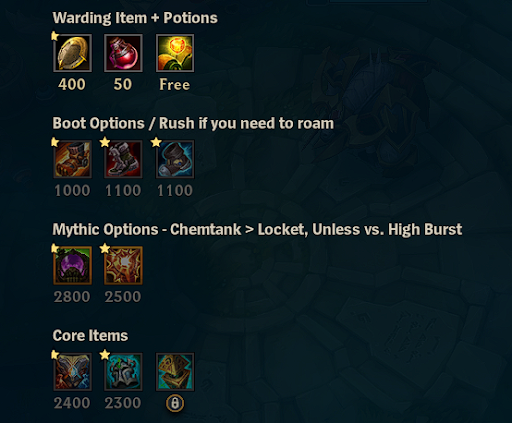
Chemtank is your go-to Mythic, with Locket being secondary. After that, most everything is whatever and can be adapted to the enemy comp. Take Tabis (Steelcaps) if you’re against AD, Merc Treads if you’re against heavy CC and AP. Mobis are great for roaming if your AD is trolling and you need to ditch them. But yeah, Alistar’s really flexible in items.
So, game to game, our load can be adapted to whatever we’re up against on the enemy side. Locket is typically taken as a response to all-in and burst since it can be popped as a fight starts to add extra survivability to everyone. Chemtank naturally synergizes with Alistar offering him the defensive stats he cares about while helping him run-fast and get in range for his combo. Aphro already spoke on the boots, so no need to ramble there.
Afterwards, our core items are defensive picks like Zeke’s and Knight’s Vow which offer secondary effects that benefit the team or primary carry while giving Alistar Armor, MR, Health, and Ability Haste.
Vigilant Wardstone isn’t something that you often see taken throughout lower ELOs, as its vision utility often goes under valued. But, it offers Alistar Ability Haste and extra control wards to allow him to set the edge in terms of vision denial, making encroachments around neutral objectives that much more dangerous.
If Vigilant Wardstone isn’t something you want to opt for, here are some secondary options that are worth considering:
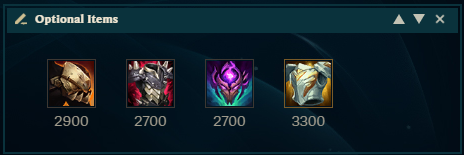
Roaming is based on your wave control. If your wave control is garbage, it’s really hard to roam since your ADC isn’t going to be able to farm. This means you’ll have to stay in lane to be pressure so they can. But, if your wave control is great, like if you push in the wave to turret so you have no reason to be there, or if your ADC is fine by themselves, you can look to make a roam. Coming out of base is also a great time to look for a roam.
It’s important to keep your movement adaptive. When roaming is concerned, a conversation you should have with yourself is, “Is it more valuable for me to play around my AD or around another teammate?” Reason being, every player in Solo-Queue is different and comes into the game with their own expectations. If you load in as a Sivir-Alistar lane, and Sivir is only concerned with wave clearing and doesn’t really want to fight, then your kit and abilities aren’t being properly utilized. So, you can make it your goal to place an emphasis on roaming to get someone else on the team further ahead since you have ample early game pressure.

Or worse, your lane partner is having an off game, and they’re unable to maintain any amount of tempo or control of the lane, even with you backing them up. Making a realistic evaluation to ‘abandon’ them, and put your eggs into another basket is a fine conclusion to make.
Your cue as to when to give up on your ADC is when they’re pretty much useless. If they don’t have items or can’t impact fights, it’s better to roam and try and get Mid or Jungle snowballing. And this is like when they’re 0-4, by the way.
One of the keys to Support play is to maintain an adaptive mindset throughout the game. Isolating your team’s primary carry is just one aspect of that adaptation. The secondary thought that you should consider is who the enemy’s primary carry is.
As a Support, you’re often the one packing the most high-impact abilities on the map, and in our case with Alistar, we can easily lock down a primary target for 2 seconds with our W+Q combo alone. Even more with an E-buffed auto. So, if an enemy carry is absolutely taking over the game, Alistar’s kit can respond well by locking them up to allow the team to shut them down. In this process, you’re not only disabling the enemy, but you’re also buffing your chances to get over their edge.
With positioning, it depends on if you have another frontline. If you’re the only frontline, then yeah, you gotta be in the lead and looking to make the engages. But, if you’ve got another frontliner like Sion, then you can look for flanks or engages on the side to get onto their backline to enable your team.
This rounds into the adaptation mindset into considering your team composition. You may select Alistar early in the draft and aim to be the primary tank for your team, but your Top Laner is an Ornn main, and your Jungler is a Zac main. Two champions that can really play the engage/secondary engage areas really well. So, as the Support, into your factoring of the biggest threats and hardest carries, it’s on you to adapt your positioning to complement what is present on your team. You may think, “I’m the guy that’s gonna start the fight!” but in reality, it may be best for you to sit back and act as a peel-bot for your AD or Mid.
Consider the in-game strength of your teammates as you reach the mid-game too. Factors like items, levels, if they’re tilted in chat, etc. If your Top Ornn had a rough early and is barely scraping by with a single item and is flaming in chat, while you’re packing two items and are running over Bot Lane, it’s better for you to act as the team’s secondary engage option until he catches up. The same goes if your primary engage is down early, and you’re relatively stronger.
Catching a feel for the overall ability and mindset of your team is super important as Support, and on Alistar you possess a flexible kit that can adapt to nearly any given situation.
There you have it! That’s pretty much everything you need to know about Alistar to play him effectively. From his abilities, to his rune and item setups, to his matchups and positioning tricks!
Once again, I want to thank Aphro for taking the time to lead us to greener pastures with his information, and I hope you all have success with Alistar with all the new info he gave us here. Good luck in Solo-Queue guys and I hope you have an a-moozing time taking advantage of all the info that’s here!
If you’re wanting to catch more of Aphromoo’s gameplay you can catch him live on Twitch. And if you want to know what’s going on with him personally, you can follow him on social media: